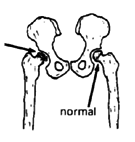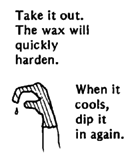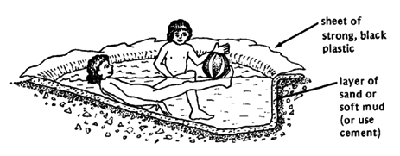Disabled Village Children
A guide for community health workers,
rehabilitation workers, and families
PART 1
WORKING WITH THE CHILD AND FAMILY:
Information on different Disabilities
B. Recognizing, Helping with, and Preventing Common Disabilities
CHAPTER 15
Painful Joints

Joint pain in children has many causes. Depending on the cause, different treatments may be needed. The chart that follows will help you decide what the cause of chronic (long-lasting) joint pain in a child might be. However, other less common causes may also be possible. Sometimes laboratory tests may be needed to be more certain.
Specific treatment is needed for certain kinds of joint pain-especially those caused by infection. However, some basic principles of care and therapy apply to most joint pain, regardless of the cause. Following the chart of causes, you will find some general guidelines for the care of joint pain. These guidelines are described in more detail in Chapter 16 on juvenile arthritis.
Three chapters on disabilities with joint pain are "Juvenile Arthritis" (Chapter 16), "Rheumatic Fever" (Chapter 17), and "Hip Problems" (Chapter 18). However, arthritis (joint pain and damage) can occur with any disability where paralysis or muscle imbalance cause abnormal positions or twisting of joints. Many children with polio develop painful dislocations or, when they are older, arthritis.
NOTE: The chart does not include the manyinfectious diseases that may cause temporary joint pain. These do not usually lead to long-term disabilities. For details of diagnosis and treatment of illnesses that cause temporary joint pain, consult a health worker or see a medical text such as Where There Is No Doctor.
|
CAUTION:Try not to confuse similar illnesses. Two of the most common causes of joint pain in children are rheumatic fever and juvenile arthritis. Even some doctors and health workers get them mixed up and diagnose juvenile arthritis as rheumatic fever. The two illnesses do have similarities. However, rheumatic fever almost always follows a period of sore throat with fever. If the child did not have a sore throat, probably the joint pain is not due to rheumatic fever. When in doubt, however, 10 days of penicillin pills may be a wise precaution. |
Carefully study the differences between the common causes of joint pain. If you are not sure, seek help from someone with more experience.
COMMON CAUSES OF CHRONIC JOINT PAIN IN CHILDREN (pain that lasts more than 2 weeks or keeps coming back)
|
Problem |
Age it often begins |
Pain in one or in several joints |
Fever |
Other signs |
Treatment and therapy |
|
rheumatic fever |
5 to 15 years old |
Usually pain is in several joints. (Rarely it begins with severe pain and swelling in only one joint, but often there is also some pain in other joints.) Often pain starts in ankles and wrists, then knees and elbows. Pain may change from some joints to others. 
|
High fever is typical (usually starts suddenly). |
|
|
|
juvenile arthritis (also called juvenile rheumatoid arthritis or Still's disease) (See Chapter 16.) |
Any age, but often begins between 2-7 or 9-12 years old Lasts for years (Often the arthritis gets better when child becomes sexually developed) |
May affect few joints, many joints, or almostall joints. 
(in 1/3 of children it begins in only one joint-later it may affect others.) |
Often some fever when pain is worst. (Rarely, it begins with high fever.) |

|
|
|
destruction or slipping of cap of thigh bone at the hip (See Chapter 18.) |
Destruction: mostly boys 4~8 years old Slip: mostly boys 11- 16 years old |
pain in one hip (rarely both) 
Destruction: Cap of head of thigh bon breaks into pieces and gradually re-forms in 2 to 3 years X-ray needed to make definite diagnosis |
no fever |

|

|
|
below-knee pain (Osgood-Slater's problem) |
Boys 11 -18 years old |
usually oneknee only 
painful swelling over bone here due to loosening of bone surface |
no fever |
|
|
|
'hot' Infection of a joint (bacterial infection: staphylococcus. streptococcus, typhoid, etc.) |
any age. but rarely in very young children |
one hip, knee or ankle joint rarely more than one joint |
often low fever, sometimes high fever, at least at first |

|
|
|
'cold' or 'slow' infection of a joint tuberculosis (TB), (or less commonly, syphilis, gonorrhea, or fungus - which are not discussed here) |
any age, but mostly in older children and young adults |
one hip or knee, or in backbone (See TB of spine, Page 165.) 
Joint may gradually become large or deformed, but not very hot or red. often much pain (sometimes no pain until the bone or joint damage is severe) |
no fever |
|
|
|
sprains and torn ligaments |
older child or adult |
one joint only 
hot and swollen at first |
no fever |
|
|
|
injury to joint surface (for example: torn meniscus, bursitis) |
older child or adult |
usually one joint only, often the knee |
no fever |

|
|
|
dislocated joint due to injury (dislocation is when a bone comes out of its socket) |
at birth or in older child |
one joint Hips, shoulder, and elbows are most common. |
no fever |

|
|
|
dislocated joint due to muscle weakness or muscle imbalance |
occurs in older child with polio, other paralysis, or arthritis |
usually one joint 
pain mild to severe, often occurs with weight bearing and increases with time. |
no fever |

|
|
How to care for painful joints
1. REST THE JOINTS

The more painful the joint, the more it needs rest. Some movement is important, but no forceful exercise or heavy use of the joint.
2. HEAT AND COLD
Applying heat (see side box) or cold to the joint often reduces pain and makes motion easier. For cold, use packs of ice wrapped in a cloth or towel for 10 or 15 minutes. Experiment to see which works better. Usually cold works better on hot, inflamed joints and beat on sore, stiff joints.
Hot wax can be used instead of hot water. Some specialists say that it does not do more good than hot water, but persons with arthritis find it very soothing.



|
|
HOT SOAKS
|
3. PAINKILLERS

Usually aspirin works best, because it reduces both pain and inflammation. For doses and precautions, see Page 134.
Note: For severe pain, splints to prevent motion help reduce pain and prevent contractures.
4. RANGE-OF-MOTION (ROM) EXERCISES

It is important to move the joints through their full range of motion at least twice a day (especially if splints are used). If it hurts, apply heat or cold first, and move them very slowly. Do not force! (See Chapters 16 and 42.)
5. EXERCISES WITHOUT MOTION

These are exercises to strengthen muscles without bending the painful joints. For example, a child with a painful knee can keep her thighs strong by tightening her thigh muscles while her leg is straight. She should hold the muscles tight until they get tired an begin to tremble. This will strengthen them and keep them strong. (See Page 140 and Page 368.)
6. CONTINUE DAILY ACTIVITIES

With most joint pain, it is important that the child remain fairly active. She should try to continue with all daily activities that do not strain or overwork the painful joints. Moderate activity is usually recommended (except for acute infections or injuries, when complete rest may be needed for several days).
Designs for therapy baths
Floating and playing in water provide exercise and therapy for many kinds of physical disabilities - especially those in which movement is limited because of pain or muscle spasms.

For children who have the opportunity, bathing, swimming, and playing in rivers and ponds with other children is good-but only when the rivers or pools are not dangerous and do not transmit diseases |

|
TUBS OR TANKS OF SUN-HEATED WATER (solar heating)

Bathing in warm water is especially helpful. The penetrating heat of the water helps to improve blood flow, calm pain, and relax the muscles.

You can dig a hole in the ground and cover its sides with plastic sheets or cement to prevent the water from leaking out. So that the sunlight heats the water faster, use black plastic, or paint the cement a dark color. (Green is friendlier than black.)
TUB WITH A SELF-ClRCULATING SUN HEATER

INFORMATION ON ASPIRIN FOR SWOLLEN JOINTS IN PERSONS WITH ARTHRITIS OR RHEUMATIC FEVER
Aspirin (acetylsalicylic acid) is usually the best medicine for joint pain:
- Aspirin not only helps to control pain, it reduces inflammation (swelling and damage to joint surfaces). Thus it helps stop destruction of the joints. Many other painkillers do not do this.
- Aspirin is not expensive.
- When taken correctly, aspirin has fewer risks, dangers, and complications than most other medicines for joint pain.
In order for aspirin to work well without causing problems:
- Take the correct dose at the right times every day.
- Keep taking the same amount of aspirin even after the pain has lessened.
This will still help control swelling and let the joints begin to heal. - Take strict precautions to avoid stomach upset.
PRECAUTIONS
A. Aspirin is an acid. It can cause stomach-ache, chest pain (so-called 'heartburn') or even make holes (ulcers) in the stomach. To avoid these problems:
- Always take aspirin with food or a large glass of water.
- If this does not prevent stomach pain, take the aspirin not only with food and lots of water, but also with a spoonful of an antacid such as Milk of Magnesia (magnesium sulfate), Maalox, or Gelusil.
Stop taking aspirin if:
- stomach pain still occurs after following the above precautions,
- you start to vomit blood,
- you start to shit blood, or if your shit looks like black tar (digested blood).
B. Too much aspirin will poison the body. (The dose that will reduce inflammation is almost as much as the dose that can poison.) An early sign of poisoning is ringing in the ears. If the ears begin to ring, stop taking aspirin until it stops. Then take it again, but in a slightly lower dose.
C. Keep aspirin out of the reach of small children.
| CAUTION: To prevent choking do not give medicine to a child while she is lying on her back, or if her head is pressed back. Always make sure her head is lifted forward. |
DOSES OF ASPIRIN FOR ARTHRITIS AND RHEUMATIC FEVER
500 mg. tablets:

Adults: 2 to 3 tablets, 4-6 times a day
Children, 8-12 years: 1 tablet, 4-6 times a day
Children, 3-7 years: half a tablet, 4-6 times a day
Children, 1-2 years: one-quarter tablet, 4-6 times a day
If there are no swollen joints, use another medicine just for pain. This is very important if aspirin causes too many side effects. For other medicines for pain, see the Green Pages in Where There Is No Doctor.
|
CAUTION: Aspirin tablets for adults usually come in 325 mg. (5 grain) or 500 mg. (8 grain) tablets. Children's aspirin usually comes in 81 mg. (1 1/4 grain) tablets. Be sure to figure out the dose correctly. Avoid aspirin combined with caffeine or with other painkillers. |
The dosage given here is the anti-inflammatory dosage, which is double the normal dosage for reducing pain and lowering fever.
The dosage is based on 100 mg. of aspirin for each kg. of a person's weight each day. For example, a child weighing 25 kilos would take 2500 mg. each day, or 1 tablet of 500 mg. 5 times a day (always together with meals or lots of water).
The dose of aspirin for your child is: _________________________________________
Disabled Village Children
A guide for community health workers,
rehabilitation workers, and families
by David Werner
Published by
The Hesperian Foundation
P.O. Box 11577
Berkeley, CA 94712-2577





